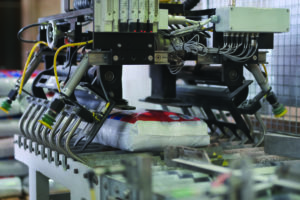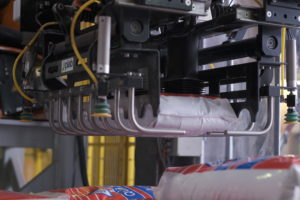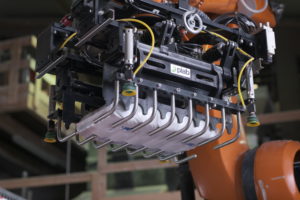
The bag gripper from Piab takes sacks off the roller belt. The width of the gripper was customized according to the roll spacing.
At the company Sapho GmbH, a company of the Bilgram Chemie Group, the old bag gripper no longer provided the necessary performance. The regions of southern Germany, Austria, and parts of France are supplied by Sapho with de-icing salt from its up to 50,000 tons of salt warehouse, which is partly filled from May to October from mines in the region.
When visiting another company, they noticed a better gripping solution. Of particular interest was that no one had to monitor it directly — freeing employees for other tasks. To be well prepared for the upcoming winter season, they decided to invest in a new gripper.
“The impetus was that we wanted to get more power out of the machine and wanted to pack the pallets cleaner and more dimensionally stable. With the combination of robots and grippers from Piab, we are quick at the time when it counts,” said Uwe Grundstein, Technical Director at Sapho.
Piab’s hybrid bag grippers are designed precisely for payloads of up to 50 kg. Accordingly, they are constructed for the handling of 10, 25, and 50 kg of salt bags from Sapho.

The bag gripper reaches the pallet.
The hybrid gripper is attached to a robotic arm that removes the sacks and bags from a roller belt on which they are placed after filling. It grabs the sacks from above, drives the forks on both sides between the rollers of the belt, and thus picks up the bag on the underside. As a result, the bag lies on the massive gripper fingers during movement. For the hybrid bag gripper to fit precisely to the existing system and in particular to the roller belt used by Sapho, the fork spacing was adapted to the spacing of the rollers.
“In this way, we could deploy a standard product and adapt it to customer needs with just a few changes,” said Roland Singer, Team Leader Vacuum Automation & Robotic Gripping Division at Piab.
When laying down the bags, the gripper fingers open first and then the integrated cover plates. As a result, the bags are kept in shape during drop-down and stacked firmly and dimensionally stable on the pallets.
Grundstein explained,
“From our loose salt warehouse where we store a literal mountain of salt, we automatically fill big bags, PE sacks, bags, and buckets at more than ten machines. This setup equals more than 800 to 1,000 pallets a day. Particularly, the palletizing of the bags had to run with much higher cycle times than before to increase productivity. With the new hybrid bag gripper and a minor process optimization, we can now palletize nine bags per minute compared to six bags with the old system. This corresponds to up to 16 pallets more per day and thus more than half a truckload. In addition, the process now runs smoothly and without damaging the bag.”

The grippers can move sacks of up to 50 kg.
“Our employees are relieved further, too. Thanks to the automatic intermediate layer handling integrated into the gripper, palletizing of the 10-kg sacks eliminates the need to stoop and manually place a cardboard liner on each pallet. This protects the back and has the advantage for us that the employee can devote himself to other tasks. It also eliminates the need to interfere with the automated process,” added Manuel Bender, Deputy Head of Filling Solids.
“We used the summer break to retrofit the plant so that it is now ready for winter business. The installation was simple and smooth — basically like plug and play,” said Grundstein.
The bag gripper range is suitable for palletizing plastic, fabric, or paper bags containing grains, chemicals, dog food, minerals, and many other products. In addition to the adjustable hybrid bag grippers, static bag grippers are also available. Both types are designed for payloads of 25 and 50 kg. They eliminate the need for custom tools and can usually be set up in under five minutes. They are made of safe, solid stainless-steel gripper fingers. The cover plates are used for precise and tight placement of the bags on the pallet. Both gripper types can be optionally equipped with suction cups for placing intermediate layers or pallet hooks.
Piab
www.piab.com
Filed Under: Pneumatic Tips